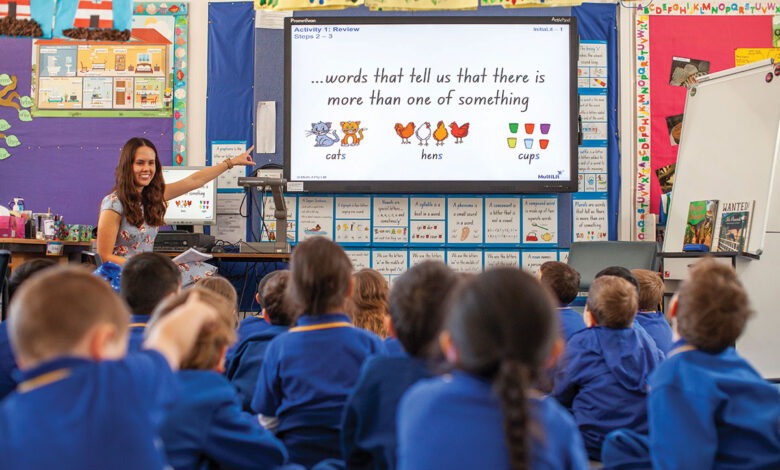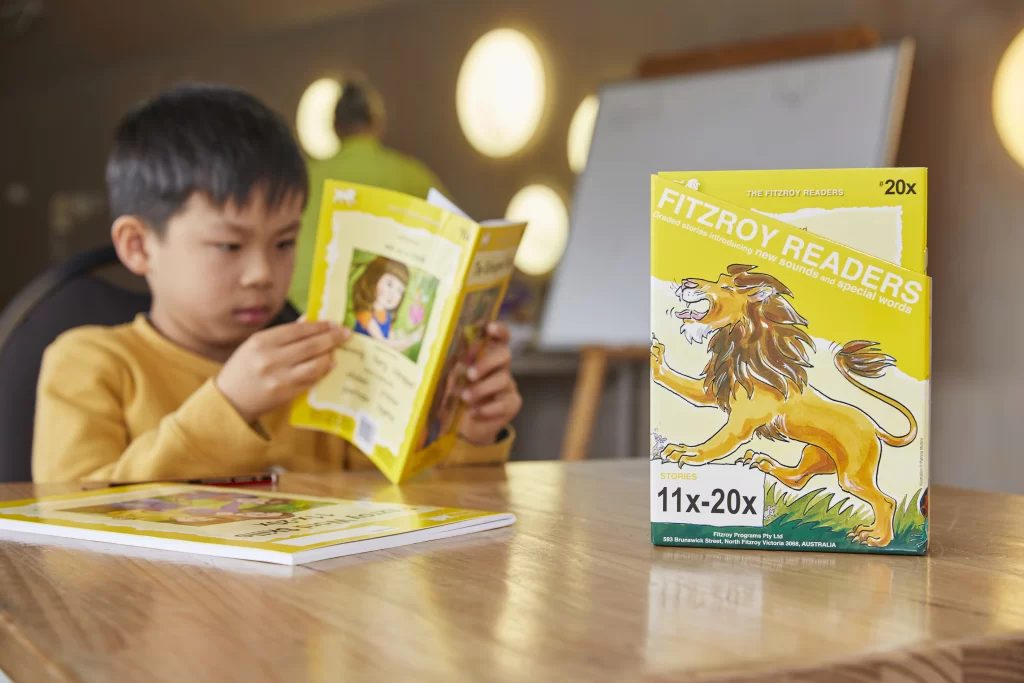Undertaking a school literacy review

With literacy standards declining, schools are racing to review and strengthen their programs.
Among the concerning trends are significant gaps between literacy levels of boys and girls increasing between Years 3 and 9.
In a 2020 analysis of NAPLAN writing test results, Thomas remarks that “while boys fell further behind girls at every tested year level, the rate at which girls outperformed boys was greatest between Years 5 and 7”. Corroborating studies from Edith Cowan University and the University of Tasmania, such as Vesife Hatisaru and David Hicks’s discussion of gender differences in reading achievement, suggest the transition from primary to secondary school in particular poses challenges for boys’ literacy achievement.

Researchers also suggest teacher perceptions, style of test questions, and parental expectation of academic achievement contribute to widening gender gaps in literacy outcomes.
Immense pressure has been placed on schools to improve these outcomes by taking a more structured literacy approach, so how should schools review their existing approach? What changes are schools implementing around the country?
We sought these answers from some leading literacy programs to find out more.
Industry expertise on literacy program design
Evidence-based instruction
“Schools that are changing their practice are all moving towards adopting evidence-based instruction,” says Dr Jennifer Buckingham, the Director of Strategy and Senior Research Fellow at MultiLit: “It is never the reverse; I never see schools giving up systematic and explicit instruction and taking up whole language or balanced literacy!”

She affirms: “Schools should make sure their literacy programs include systematic synthetic phonics for beginning and struggling readers, as well as in-depth vocabulary and comprehension instruction, plus lots of opportunities for students to practice reading and access great books”.
“Evidence-based literacy instruction is systematic, sequential and explicit. That is, there is a planned sequence of content in all the essential aspects of literacy from phonemic awareness, phonics, and fluency, to vocabulary and comprehension. It is also taught through explicit instruction methods with cumulative reviews and progress monitoring using valid assessments.”
Especially so since COVID: “Teachers and schools are expected to meet an enormous range and diversity of student needs. Following a ‘Response to Intervention’ (RtI)protocol, if students receive high quality evidence-based instruction from their first weeks at school, a minority (around 25 percent) will need some extra support. Of these, most will make good progress if they are given an effective and appropriate intervention program. If the RtI protocol is followed rigorously, around 5 to 7 percent of students have more significant educational or behavioural needs that require specialist and targeted intervention. This allows resources to be focussed on students with the greatest need.”
Encouraging schools to evaluate programs very carefully before investing in one, Jennifer says to “make sure it aligns with the findings of scientific reading research and has some evidence of effectiveness”, and cautions schools not to rule out using a published program: “A good, published program has been tried and tested, and can significantly reduce teacher workload once they have gained some experience in using it.”
Long-term outcome focus

Jen McVeity, Seven Steps creator and CEO believes that: “All programs and approaches aim to improve literacy outcomes, but it is the long-term outcomes that are key.”
She says: “Schools need to source programs that suit their needs, onboard teachers prior to training, have a ‘driver’ in the school to keep up momentum, and carry out regular fidelity checks to identify who needs support, share successes, and fine-tune the program.
“The responsibility of any program provider, meanwhile, is to create high-quality materials that leave room for teachers to make the program their own based on their expertise and knowledge of students. They also need to provide ongoing support to schools and teachers to ensure that the program is implemented effectively and has the desired outcomes.
“A huge benefit of COVID (yes, there were a few) is that students have been given more control over their own learning. Teachers need to scaffold and support the learning process, but students need to be empowered to create their own learning paths. Very few students will need to write an essay or formal narrative outside of the classroom. Instead, they will need to be able to write blogs, web content, social media posts, and short-form videos. Teaching resources that reflect real-world contexts are more engaging for students at both primary and secondary levels.”
Additionally: “Engagement improves when there is peer-to-peer collaboration and feedback. Research shows that feedback, interaction, and collaboration are beneficial to the learning process. This is not something that comes naturally to all students though, so explicitly teaching and facilitating collaborative learning is essential.
“Often, writing is seen as a quiet, silent activity, yet it is much more effective when students collaborate. There is an overemphasis on the secretarial side of writing—spelling, grammar, and punctuation—in schools. However, brainstorming ideas and getting peer feedback facilitate learning and should be kept at the forefront of any writing classroom.”
Phonic methods boost acquisition
Fitzroy Readers founder Philip O’Carroll acknowledges that “literacy education in Australia has gone through a major change”.

“It is now obvious to many primary schools that phonic methods greatly boost the acquisition of literacy. By introducing one spelling pattern at a time in a sequential fashion, children are saved from the jumble of scores of English spelling patterns that must eventually be mastered in readiness for secondary education.
“Before the return of phonics, the sheer volume of raw memory required to accumulate the spellings of English left hordes of students floundering. Phonics became permissible again after the 70s and this opened a door to greater literacy. By selecting digestible vocabulary in the early years, and introducing odd spellings only in small steps, much progress has been made.”
The English language is tricky: “Hundreds of groups of words share their own spelling pattern, i.e., mark, Mars, yard, and farm. Further, there are English words that don’t belong to any group of similar spellings, i.e., busy, sew, and choir. Suitable reading books for the early years employ a chosen set of words with a matching spelling pattern, plus a few words that are clearly separated out as having their own idiosyncratic spellings.
“Schools that take a synthetic phonic approach to teaching literacy have shown astonishing and heartening results in government tests.”
Measure student engagement
“Spend your school’s time and money on the best resource in any classroom: the teacher,” says Cleverbean Co-Founder, Lucy Chambers. She has spent 15 years as a classroom teacher and tells us that while schools “are moving towards evidence-based learning programs” many are “currently doing so blind-folded, without the tools or time to make consistent changes”.

To translate evidence-based learning into empowering, time-saving tools for teachers, Lucy recommends: “Where possible invest the time needed for collegial planning and development of programs as well as strategically implementing new school wide strategies one at a time so teachers have time to understand, practise, embed and feel less overwhelmed.”
Rather, new programs and strategies must “come from a place of support and development,” she says. There has been a “focus on individualised learning for a number of years attempting to address the alarming decline in literacy rates and any classroom teacher can meet individualised needs if they have access to quality teaching materials.
To implement best practice, Lucy recommends undertaking a review first, to measure student engagement: “Question whether students are being given a critical/creative task or just another worksheet. Also, ask whether quality texts are missing from the classroom; students need technical, colourful vocabulary to develop their language skills.”
To improve literacy outcomes, as a starting point, she advises teachers to “share learning intentions and show how they are connected to the curriculum and relatable to students”. She says: “Visible success criteria drive clear learning outcomes so that students can monitor their own learning as well as paving the way for explicit and timely feedback.”
Furthermore: “Rich literature embedded into the program helps improve and develop vocabulary in the classroom. Formative assessment practices like exit slips or quick Post-it responses, work to ensure you understand your students and their learning needs.
“Scheduling actionable feedback that is specific to individual students and embedding student-led feedback practices in your classroom, such as 2 stars and a wish or praise, question, polish can deepen learning and enrich student engagement.”







